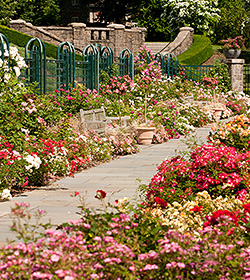Roses are Red…
Posted in Gardening Tips on June 25 2014, by Sonia Uyterhoeven
Sonia Uyterhoeven is the NYBG’s Gardener for Public Education.
 The roses in the Peggy Rockefeller Rose Garden demanded a lot of patience this year, but it was well worth the reward. The harsh winter resulted in severe die back for many of the hybrid teas and floribundas, so we cut them back hard in the spring and gave them a jolt of nitrogen-rich fertilizer to get them going.
The roses in the Peggy Rockefeller Rose Garden demanded a lot of patience this year, but it was well worth the reward. The harsh winter resulted in severe die back for many of the hybrid teas and floribundas, so we cut them back hard in the spring and gave them a jolt of nitrogen-rich fertilizer to get them going.
The cool spring had the roses growing at a slow and steady pace and they sat in bud throughout the month of May, waiting for warmth. Generally, our roses start to open around the third week in May and peak bloom spans from the end of May into the first few weeks of June. This year the old-fashion garden roses were pretty much on schedule but our repeat-bloomers were a good two to three weeks behind.
The warm weather finally arrived, and it was certainly worth the wait. To call the roses resplendent would be an understatement. I drove by late last week and my view from the top of the hill was a mosaic of colors as vibrant as an Andean textile.
The roses are just past their peak, but only just. I spoke with one of our rose gardeners, Bernie Conway, as he was beginning the daunting task of deadheading the repeat blooming roses so that they will flower again in the middle of summer. We have over 600 varieties of roses in the garden with somewhere in the range of 3,000 plants. Pardon the pun, but Bernie certainly has his work cut out for him.
We like to deadhead our roses by cutting back fairly hard in the garden—at least to a five-leaf set and always to an outward facing bud. Our reasoning is that we are cutting back to a nice sturdy stem that will support subsequent blooms. Some of our roses, like our Knock Out® Collection, seem to grow non-stop. They will often be pushing new growth before you get your pruners to it. Just cut back to the new growth and let it do its thing.
When you give your roses a haircut like we do, make sure that you keep them well watered and give them some fertilizer to provide the energy they need for another growth spurt. We use many products at the garden to fertilize our roses. Some good organic granular products that are easy to find are Rose-tone® or Dr. Earth®. Liquid fertilizers that we use aplenty are Monty’s Joy Juice®, Organic Gem®, and Neptune’s Harvest. If this all smells a little fishy, you are absolutely right—but the odor doesn’t last.
While some of the roses are slowly beginning to fade, many of them are still going full steam ahead and are full of buds. Here are some to look out for in the following week:
Rosa ‘Desmond Tu Tu’ – a disease resistant lush red floribunda hybridized by Kordes that will make your sweetheart swoon.
Rosa ‘Bengali™’ – another strong performer from Kordes that will provide just the right splash of apricot for those with a penchant for pastel.
Rosa ‘Tequila™’ – a floribunda from the hybridizer Meilland that gives you three for the price of one. The buds are orange/apricot, the flowers open to butter yellow and fade to pinkish white—a glorious color combination.
Rosa ‘Mandarin Ice™’ – if the color is right for you, then this is your rose. Mandarin orange flowers will dazzle. This is one of our top performers in the garden and scores high for disease resistance and ease of culture.
Rosa ‘Fortuna Vigorosa®’ – simple five-petal flowers with yellow centers on a compact rose that will tuck beautifully into any mixed border. This one is covered with buds that are just waiting to explode.
Make sure you stop by the Peggy Rockefeller Rose Garden to absorb the sights and scents.

